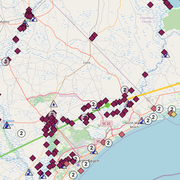Blake A Draper
Blake Draper is the WIM Development Team Lead with the Web Informatics and Mapping (WIM) team at the Upper Midwest Water Science Center.
I have dedicated my career in the USGS to serving our mission of delivering actionable intelligence on Earth systems to relevant decision makers. I have always enjoyed working to promote and deliver USGS science through development of timely, useful, and intuitive web application and web service products.
My work is primarily client-side, developing web apps in Javascript/Typescript and the Angular framework. I also work on system administration and technology infrastructure maintenance for the WIM team. Much of my work requires configuring server environments and preparing GIS data for use in web services. My professional goal is to create useful, intuitive data visualization and data management products that advance and promote USGS science.
Professional Experience
Serve as lead developer and project manager for multi-year software development cycles
Interface with clients/cooperators to gather requirements, and present and manage development feedback
Author project proposals, technology specifications and software documentation
Lead efforts within team to implement standards and best practices approaches to agile collaborative development, workflow optimization, software testing, deployment pipelines, and software release cycles
Onboard, mentor and support junior developers with administrative and technical guidance
Assist in strategic decision-making for my team’s technology stack and software architecture planning as part of the Senior Dev Team
Education and Certifications
GIS Certificate, University of Wisconsin - Madison, 2012
M.A., Florida State University - International Affairs, 2009
B.A., Florida State University - International Affairs, 2007
Science and Products
Blake has worked on development of the projects below:
Integrated Water Availability Assessments Fundamentals
WHISPers
Providing Major Storm and Short-Term Flood Event Data
National Water Census
NorEaST: A Tool to Understand the Responses of Fish to Changes in Stream Temperature
Blake has worked on the following web applications:
Great Lakes Coastal Wetland Restoration Assessment Geonarrative Great Lakes Coastal Wetland Restoration Assessment Geonarrative
Science and Products
Blake has worked on development of the projects below:
Integrated Water Availability Assessments Fundamentals
WHISPers
Providing Major Storm and Short-Term Flood Event Data
National Water Census
NorEaST: A Tool to Understand the Responses of Fish to Changes in Stream Temperature
Blake has worked on the following web applications:






